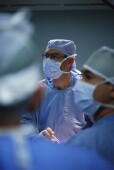New Technology No Better at Spotting 'Anesthesia Awareness'
Study comparing bispectral index monitoring to standard methods found little difference
By Amanda Gardner
HealthDay Reporter
|
E-mail this article
Subscribe to news
Printer friendly version
|

(SOURCES: Michael S. Avidan, M.B., B.Ch., associate professor, anesthesiology and surgery, and division chief, cardiothoracic anesthesia and cardiothoracic intensive care, Washington University School of Medicine, St. Louis; Gerald Frye, Ph.D., Joseph H. Shelton professor, neuropharmacology and neurotoxicology, department of neuroscience and experimental therapeutics, Texas A&M Health Science Center College of Medicine; Gary H. Morton, M.D., associate professor, anesthesiology, Texas A&M Health Science Center College of Medicine, and vice chairman, anesthesiology, Scott & White, Temple, Texas; March 13, 2008, New England Journal of Medicine)
WEDNESDAY, March 12 (HealthDay News) -- A much-touted technology designed to detect when patients are regaining consciousness while under anesthesia during surgery doesn't appear to work any better than standard methods.
Bispectral index (BIS) monitoring did not lower the incidence of "anesthesia awareness" in a large sample of patients, concluded a study from Washington University researchers that is published in the March 13 issue of the New England Journal of Medicine.
"We're left with the way we've done it in the past, that is using clinical signs of movement, high blood pressure, tachycardia, that kind of thing," said Dr. Gary H. Morton, an associate professor of anesthesiology at Texas A&M Health Science Center College of Medicine and vice chairman of anesthesiology at Scott & White in Temple. "The problem with any of these techniques is they're not 100 percent."
"This study is not showing any improvement in doing a better job of maintaining a lack of consciousness than the standard methods," added Gerald Frye, the Joseph H. Shelton professor of neuropharmacology and neurotoxicology in the department of neuroscience and experimental therapeutics at Texas A&M Health Science Center College of Medicine.
But this doesn't necessarily close the door to using the system in the future.
"I don't think that this particular study says the BIS monitors are no good," Morton said. "It basically says they're not consistently better than what we have. Even an ASA [American Society of Anesthesiologists] practice advisory says that the BIS monitor may still be helpful in high-risk patients. We need to individualize the way we use them."
"No single study provides a definitive answer," said study author Dr. Michael Avidan, division chief of cardiothoracic anesthesia and cardiothoracic intensive care at Washington University School of Medicine in St. Louis. "Our study adds some interesting information and raises some interesting questions, including why is technology adopted so enthusiastically before there is compelling scientific evidence. . . Our study certainly drives the need for larger studies."
According to an accompanying editorial, more than 21 million patients in North America receive general anesthesia each year, and as many as one or two in every 1,000 may experience some awareness during a procedure. Awareness is more common in patients who have received neuromuscular-blocking drugs, making it impossible for them to communicate their distress.
One patient, undergoing surgery to remove her right eye, heard the surgeon speak to the resident. When she realized she was awake, she tried frantically to blink her eyes and move her head, to no avail. "I was screaming at the top of my lungs, but no noise was coming out," she recalled.
The phenomenon can lead to long-term psychological consequences, even post-traumatic stress disorder.
The FDA-approved bispectral index system leads a growing market in devices promising to reduce anesthesia awareness. It is used in about 60 percent of all operating rooms in the United States yet, according to the study authors, evidence on its utility is scant.
"It works by recording information from an EEG on electrical activity in our brain," explained Avidan. "The type of electrical activity that our brain has is different when it's awake or asleep. This monitors electrical activity from the frontal area of the brain and analyzes the wave form."
For this study, 2,000 patients undergoing general (inhaled) anesthesia were randomly assigned to BIS-guided anesthesia or to conventional anesthesia. They were then assessed for anesthesia awareness at 0 to 24 hours after the procedure, 24 to 72 hours after, and 30 days after.
Two patients experienced definite anesthesia awareness in each group, an overall incidence of 0.21 percent. Five more patients (four in the BIS group and one in the control group) had possible awareness.
The device may be of benefit to patients receiving intravenous anesthesia, which is used in a minority of surgical procedures and which is considered to be a risk factor for anesthesia awareness, the authors stated.
One of the problems is that administering anesthesia is such a finely calibrated, delicate procedure that other important variables need to be taken into account.
"It's sort of like flying an airplane. There are a lot of dials to look at," Frye said. "Maintaining proper air speed is important in flying and, in anesthesia, sometimes you have to lower the depth of the anesthesia to maintain stable vital signs in the patient."
More information
For more information, visit the Anesthesia Awareness Campaign,  founded by a patient who experienced the phenomenon.
founded by a patient who experienced the phenomenon.
Copyright © 2008 ScoutNews, LLC. All rights reserved. 
HealthDayNews articles are derived from various sources and do not reflect federal policy. healthfinder.gov does not endorse opinions, products, or services that may appear in news stories. For more information on health topics in the news, visit the healthfinder.gov health library.